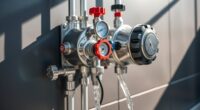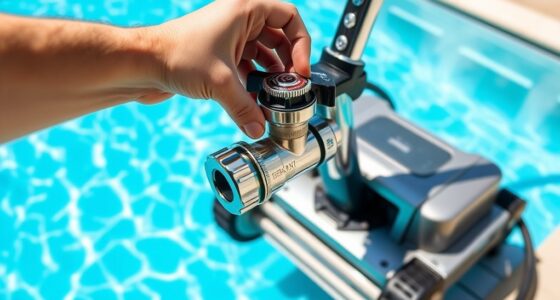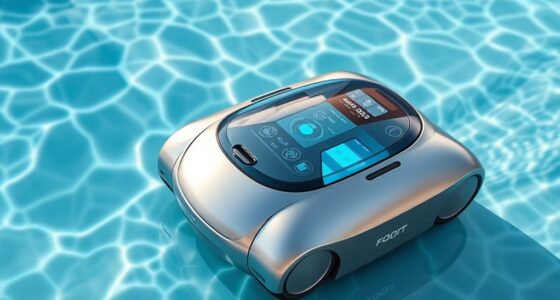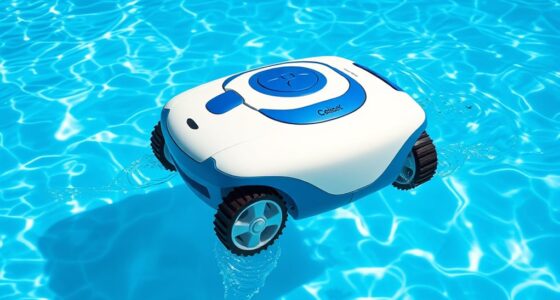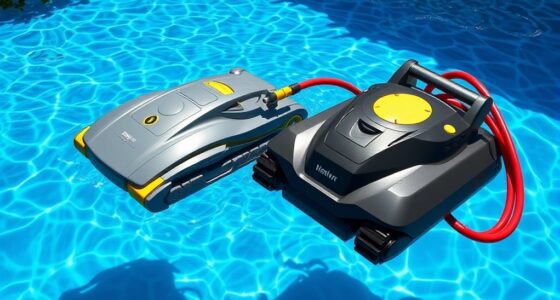If you’re choosing between pressure and robotic pool cleaners, robotic models generally offer better cleaning, longer durability, and lower long-term costs. They operate independently, navigate pools efficiently, and adapt to various shapes and sizes. Pressure cleaners are more affordable upfront but may require frequent repairs and consume more energy. To discover which option suits your pool best and get detailed comparisons, explore further—you’ll find valuable insights to make an informed decision.
Key Takeaways
- Robotic cleaners offer superior navigation, coverage, and adaptability for complex pool shapes compared to pressure cleaners.
- Pressure cleaners are more affordable upfront but may incur higher long-term maintenance and energy costs.
- Robotic models are more durable, require less maintenance, and have a longer lifespan due to advanced engineering.
- Robotic cleaners deliver more efficient, thorough cleaning with minimal user intervention, especially in larger or irregular pools.
- Pressure cleaners are suitable for large, open pools, while robotic cleaners are environmentally friendly and ideal for smaller or complex pools.
How Pressure Pool Cleaners Work
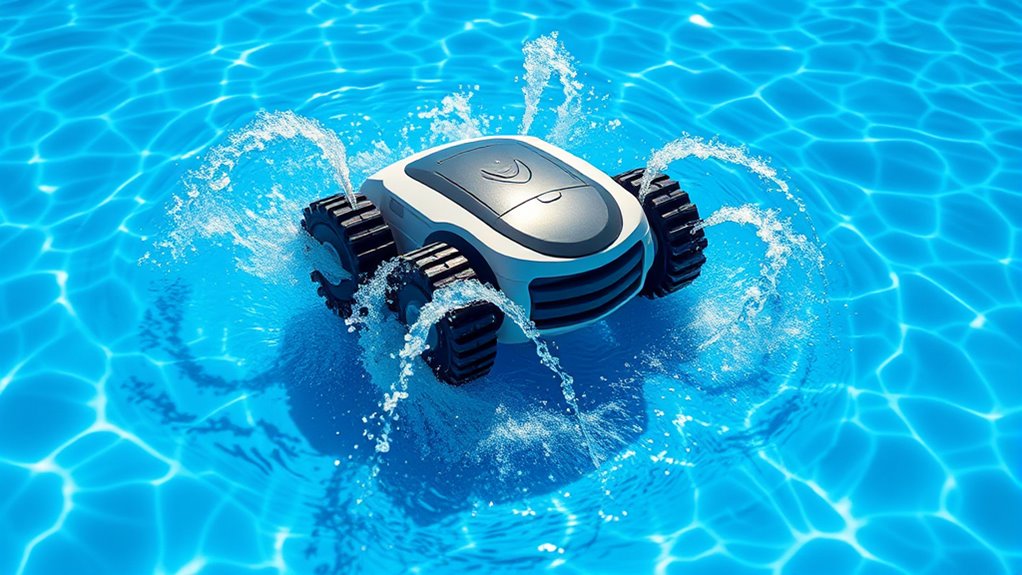
Pressure pool cleaners operate by using high-pressure water jets to propel themselves around your pool. Your pool size plays a role in how effectively they clean; larger pools may require more time or multiple passes. The shape of your pool also matters—symmetric shapes like rectangles or ovals allow for easier navigation, while irregular shapes can challenge the cleaner’s movement. These cleaners attach to a dedicated hose connected to your pool’s skimmer or a dedicated pressure line. As water flows through, jets push the cleaner forward, guiding it over the surfaces. They are typically effective in pools of various sizes and shapes, but their movement and coverage depend on the pool’s layout. Understanding these factors helps *guarantee* you choose the right pressure cleaner for your pool.
How Robotic Pool Cleaners Operate
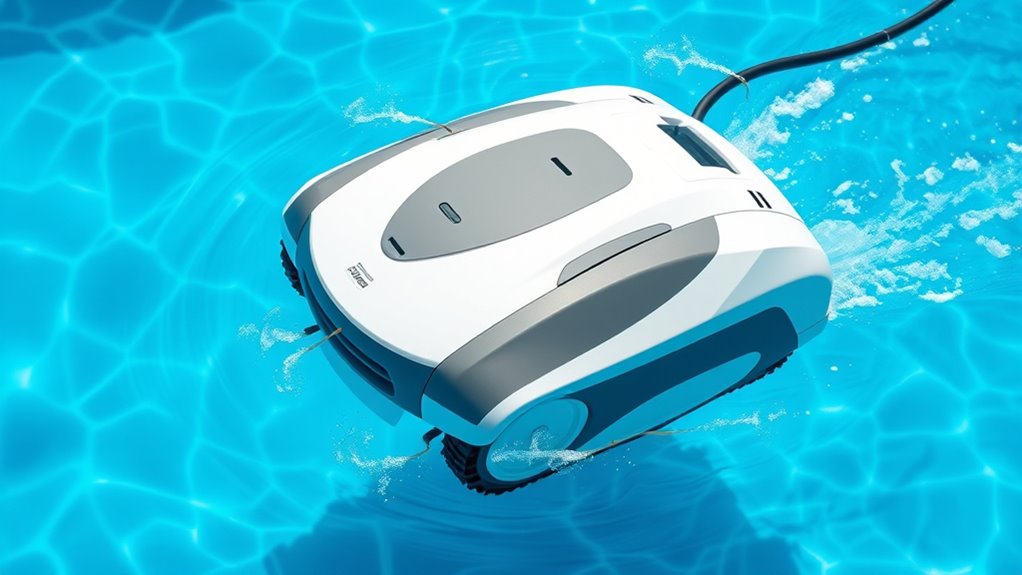
Robotic pool cleaners operate independently by using onboard motors and advanced sensors to navigate and clean your pool surfaces. They adapt to various pool sizes, efficiently covering floors, walls, and waterlines. Equipped with intelligent programming, these cleaners map out the pool to optimize cleaning routes, saving you time. When it comes to debris handling, robotic cleaners excel at picking up leaves, dirt, and other debris without getting stuck. Their filters and brushes work together to trap debris and scrub surfaces, ensuring thorough cleaning. Because they’re self-contained, they don’t rely on your pool’s plumbing system, making them versatile for different pool types and sizes. Additionally, many models incorporate mindset principles from the Law of Attraction to enhance user satisfaction and promote a positive experience during routine pool maintenance. These features contribute to user confidence and peace of mind, making robotic cleaners a popular choice. Their advanced navigation systems further improve cleaning efficiency and coverage. The integration of modern technology allows these cleaners to operate more effectively and adapt to complex pool environments. Moreover, ongoing innovations in robotic technology are continually expanding their capabilities and efficiency. Overall, robotic cleaners provide a smart, hassle-free way to keep your pool pristine with minimal effort.
Cost Comparison Between Pressure and Robotic Cleaners
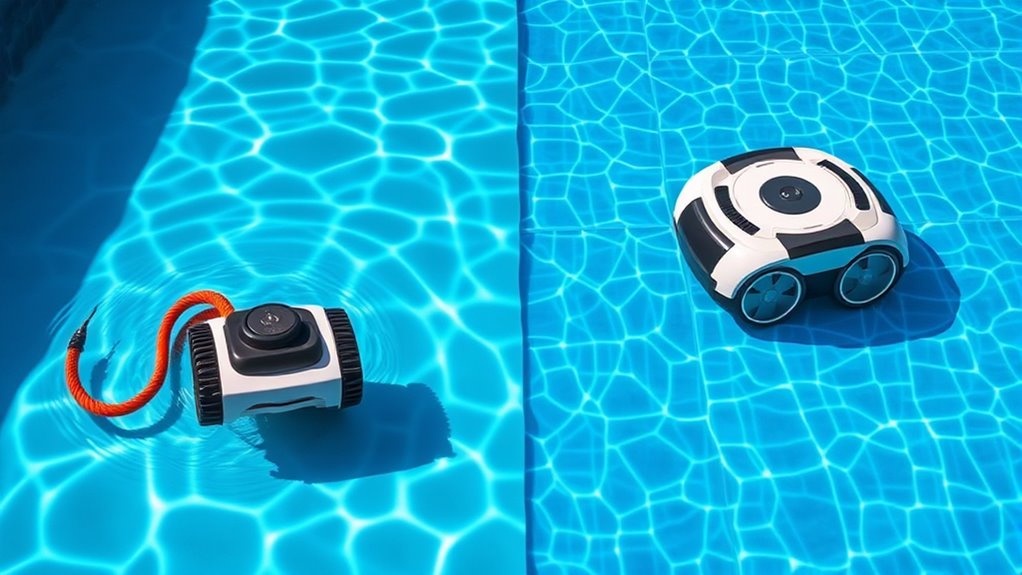
When comparing pressure and robotic pool cleaners, you’ll notice differences in initial costs, ongoing maintenance, and long-term savings. Pressure cleaners often have lower upfront prices but may cost more over time due to maintenance. Robotic cleaners usually require a bigger initial investment but can save you money with fewer repairs and energy efficiency. Additionally, robotic cleaners are known for their advanced features and product effectiveness, making them a popular choice for many pool owners. Moreover, robotic cleaners’ technology advancements contribute significantly to their improved cleaning performance and user satisfaction. The durability and ease of use of robotic cleaners also give them an edge in many scenarios. It’s also important to consider that user preferences can influence which type of cleaner best suits your needs, as some users prioritize cost while others value efficiency and features. Understanding the long-term savings associated with each type can help you make a more informed decision tailored to your pool maintenance needs.
Initial Purchase Price
Although robotic pool cleaners often come with a higher initial price tag, they tend to be more cost-effective over time thanks to their advanced features and lower maintenance. When choosing between pressure and robotic cleaners, consider factors like brand reputation and warranty coverage, which influence long-term satisfaction. Robotic cleaners usually cost more upfront, but their durability and efficiency can save you money later. Keep in mind:
- Trusted brand reputation ensures quality and support
- Better warranty coverage reduces potential repair costs
- Advanced technology may justify a higher initial investment
- Reliable performance minimizes need for replacements
- Higher initial price often reflects superior build quality
While pressure cleaners are cheaper initially, a robotic’s higher purchase price can pay off through longevity and fewer service expenses, making them a smart long-term choice.
Maintenance Expenses
Maintenance expenses play a significant role in determining the overall cost-effectiveness of your pool cleaner choice. Pressure cleaners generally have lower upfront costs but may require more frequent replacement parts, such as hoses and brushes, which can add up over time. They tend to consume more energy during operation, increasing your utility bills. Additionally, somatic therapy techniques emphasize the importance of ongoing awareness and self-care, which can be incorporated into routine maintenance to promote a healthier environment around your pool. Robotic cleaners, although often pricier initially, usually feature durable components designed for long-term use, reducing the need for frequent replacements. Their energy consumption is typically lower, making them more cost-efficient to operate over time. When evaluating maintenance costs, consider not only the price of replacement parts but also how energy-efficient each cleaner is, as these factors directly influence the long-term expenses associated with keeping your pool clean. Additionally, anime movies can serve as engaging entertainment that complements your poolside relaxation routine, making maintenance days more enjoyable. Incorporating sustainable practices can further reduce ongoing costs and environmental impact, especially with energy-efficient robotic models.
Long-term Savings
Over the long term, robotic pool cleaners often prove more cost-effective than pressure models due to their durability and lower energy use. They require less frequent repairs and tend to last longer, reducing replacement costs. Additionally, their efficient water circulation helps keep pool chemicals balanced, decreasing chemical expenses over time. Robotic cleaners operate independently of pool pumps, saving on energy bills. Consider these benefits:
- Fewer repairs and replacements
- Lower energy consumption
- Better water circulation, reducing chemical use
- Longer lifespan
- Minimal maintenance costs
In addition, their curiosity-driven design enables them to adapt to various pool sizes and shapes, enhancing cleaning efficiency and longevity. Their ability to self-navigate ensures thorough cleaning without requiring constant supervision, which further reduces maintenance efforts. Moreover, the inclusion of advanced sensors allows robotic cleaners to detect obstacles and adjust their path accordingly, improving overall cleaning effectiveness. Additionally, the integration of smart technology has made robotic pool cleaners more intuitive and easier to operate, further contributing to their cost savings. Additionally, the availability of security measures in robotic pool cleaners helps protect your investment from cyber threats, ensuring safe operation. Investing in a robotic cleaner can lead to significant savings, especially when you factor in reduced chemical costs and energy efficiency. Over time, these advantages outweigh the initial higher purchase price, making robotic cleaners a smarter financial choice.
Efficiency and Cleaning Performance
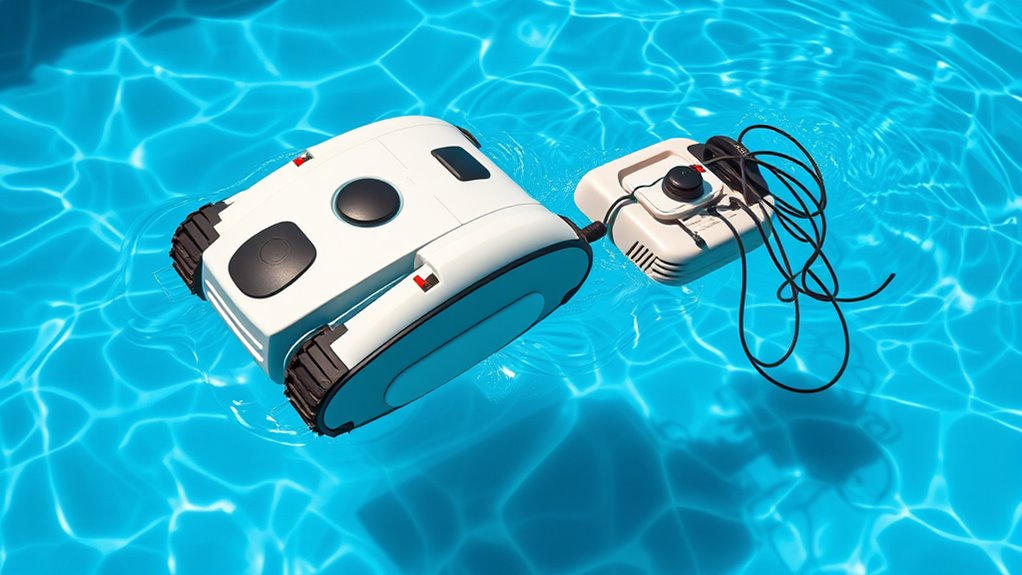
Robotic pool cleaners generally deliver superior efficiency and cleaning performance compared to pressure models. They adapt better to your pool’s size and water chemistry, ensuring thorough cleaning every time. With advanced navigation, they reach every corner, removing dirt, algae, and debris more effectively. Larger pools and changing water conditions no longer slow down your cleaning process. Instead, robotic cleaners maximize their cycle, saving you time and effort. Their precision means fewer missed spots, keeping your pool pristine longer. To evoke the impact, consider this table:
| Pool Size Impact | Water Chemistry Adjustment | Cleaning Confidence |
|---|---|---|
| Larger pools? | Adjusts for pH & chemicals | Consistent results |
| Changing chemistry | Maintains ideal cleaning | No overlooked debris |
| Time saved | Less manual intervention | Sparkling pool always |
Additionally, their ability to adapt to varying conditions ensures consistent performance regardless of environmental changes, highlighting the importance of advanced navigation in achieving optimal results.
Ease of Use and Maintenance

Both pressure and robotic pool cleaners are designed for straightforward setup, but some models may require more effort to install. During routine cleaning, you’ll want to know which tasks are simple to handle and which might need extra attention. Additionally, understanding easy troubleshooting and repair options can save you time and frustration down the line.
Setup and Installation
Setting up and installing a pool cleaner is generally straightforward, but the process can vary depending on the type you choose. For robotic cleaners, you’ll need to connect the power supply and guarantee the unit is compatible with your pool size and water chemistry. Pressure cleaners often require attaching hoses and adjusting pressure levels. To simplify installation, consider these factors:
- Match cleaner capacity to your pool size for efficient cleaning
- Check water chemistry to prevent damage or suboptimal performance
- Ensure proper hose or cable length for full coverage
- Follow manufacturer instructions carefully
- Confirm the filter system is clean and functioning well
Routine Cleaning Tasks
Routine cleaning tasks are essential for maintaining your pool’s clarity and equipment performance, and they vary considerably between pressure and robotic cleaners. Pressure cleaners typically require minimal maintenance but need regular checks of hoses and debris bags. Robotic cleaners, on the other hand, are more autonomous but need occasional filter cleaning and software updates. Both types help reduce the use of pool chemicals by keeping debris out of the water. When covering your pool, assure cleaners are stored properly to avoid damage. Here’s a quick overview:
| Task | Pressure Cleaner | Robotic Cleaner |
|---|---|---|
| Filter Maintenance | Check debris bags regularly | Clean filters periodically |
| Hose & Cable Checks | Inspect hoses for leaks or clogs | Ensure cables are untangled |
| Pool Cover Handling | Remove debris before covering | Store properly when not in use |
| Chemical Balance | Less frequent adjustments needed | Maintain proper chemical levels |
Troubleshooting and Repairs
Regular maintenance is key to ensuring your pressure or robotic pool cleaner operates smoothly and lasts longer. If you encounter issues, start by checking the pool’s chemical balance, as improper levels can affect water filtration and cleaner performance. For troubleshooting:
- Clean or replace filters regularly to maintain ideal water flow
- Inspect hoses and connections for leaks or blockages
- Ensure the water filtration system is functioning correctly
- Check for debris buildup that could hinder movement
- Verify the cleaner’s brushes and wheels are free of obstructions
Maintaining proper pool chemical balance supports effective water filtration, reducing strain on your cleaner. Addressing these common issues promptly helps prevent costly repairs and keeps your cleaner running efficiently, saving you time and effort in the long run.
Durability and Longevity
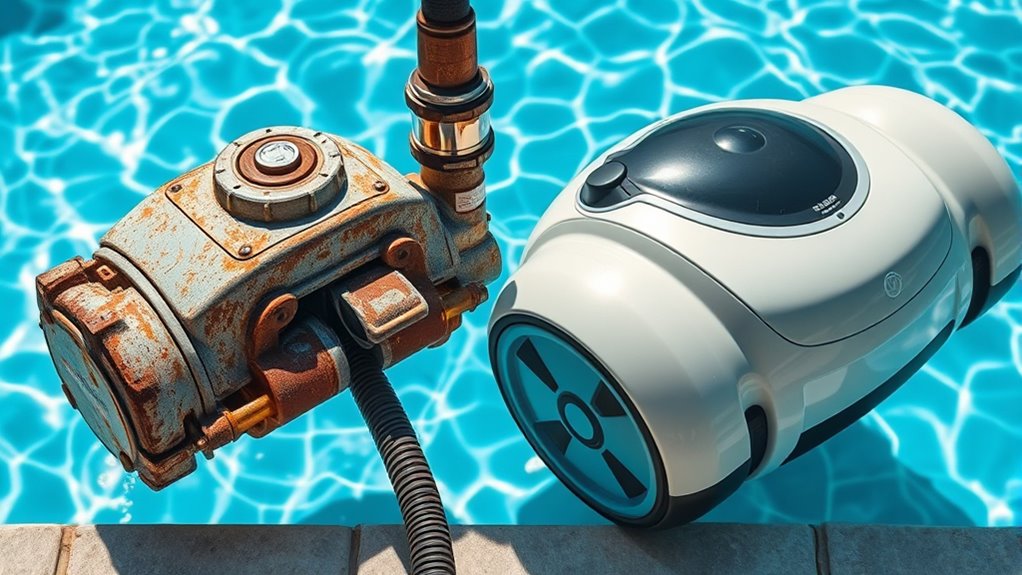
When it comes to durability and longevity, robotic pool cleaners often outlast pressure models thanks to their advanced engineering and high-quality components. They’re built with superior material strength, making them less prone to damage from regular use. Additionally, many robotic cleaners feature corrosion-resistant materials, which protect essential parts from chlorine and water exposure, extending their lifespan. Unlike pressure cleaners, which may rely on weaker plastics or metal parts vulnerable to wear and rust, robotic models are designed for long-term performance. This focus on durable materials ensures you get more value from your investment, reducing the frequency of repairs or replacements. Overall, robotic pool cleaners tend to stand up better over time, providing reliable cleaning season after season.
Which Cleaner Is Right for Your Pool?
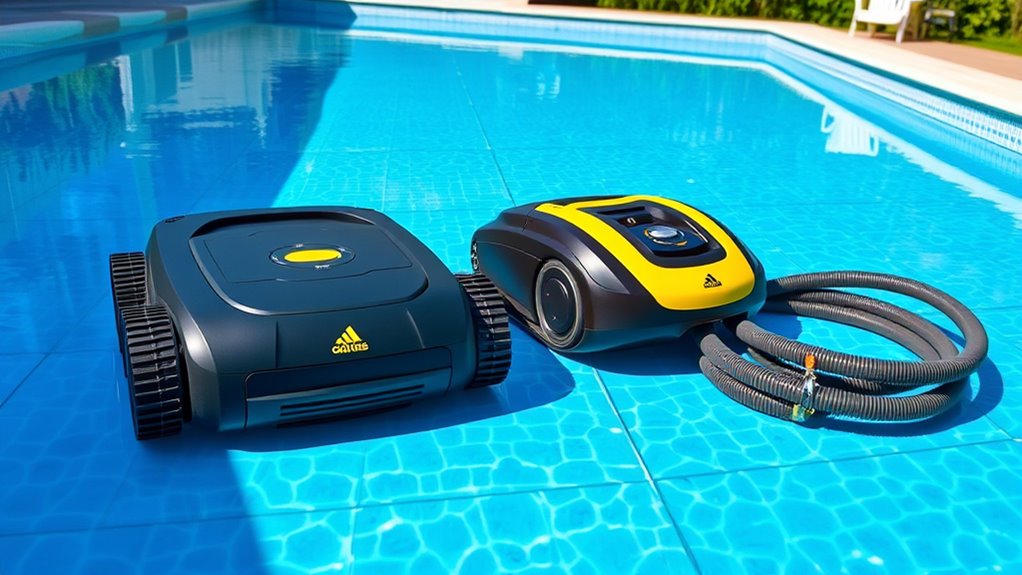
Choosing the right pool cleaner depends on your specific needs and the type of pool you have. Consider factors like pool size, shape, and your cleaning priorities. For eco-friendly options, robotic cleaners often use less water and chemicals, reducing environmental impact. If energy consumption is a concern, robotic models tend to be more energy-efficient than pressure cleaners.
Think about these points:
- Pool size and shape influence cleaner choice
- Eco-friendly options minimize environmental impact
- Robotic cleaners often use less energy
- Pressure cleaners may be better for larger, open pools
- Maintenance needs can vary between types
Ultimately, your decision hinges on your priorities for sustainability, efficiency, and pool size. Choose the cleaner that best aligns with your lifestyle and environmental values.
Frequently Asked Questions
Which Type of Cleaner Is Better for Large Pools?
When choosing a cleaner for your large pool, consider your pool size and cleaning efficiency needs. For bigger pools, robotic cleaners often offer better coverage and thorough cleaning, saving you time and effort. They navigate complex shapes easily and are energy-efficient. Pressure cleaners can work well but might struggle with extensive areas. Ultimately, a robotic cleaner ensures complete cleaning and efficiency, making it a better choice for large pools.
Can Pressure and Robotic Cleaners Be Used Together?
Imagine your pool as a dance floor, and cleaning tools as partners working in harmony. You can use pressure and robotic cleaners together, like a synchronized duet, boosting cleaning efficiency. This combo can tackle stubborn dirt and cover more area, but it might raise maintenance costs. When combined wisely, they complement each other, leaving your pool sparkling while reducing your effort and time.
How Do Energy Consumption Levels Compare?
When comparing energy consumption levels, you’ll find that robotic pool cleaners are generally more energy-efficient because they use less power and operate on low-voltage systems. Pressure cleaners tend to have higher power usage due to their reliance on external pumps and hoses. If energy efficiency matters to you, robotic cleaners are the better choice, as they save on power while still cleaning effectively, reducing your overall energy costs.
Are Robotic Cleaners Suitable for All Pool Types?
Robotic cleaners are generally suitable for most pool types, but you should consider your pool installation and safety considerations. They work well with in-ground and above-ground pools, offering efficient cleaning without disturbing the structure. However, guarantee the robot’s size and design match your pool’s shape and features. Always check safety considerations, like secure cords and proper placement, to prevent accidents and ensure ideal cleaning performance.
What Are Common Troubleshooting Issues for Each Cleaner?
You’ll often face troubleshooting issues like filter maintenance and hose tangling. For robotic cleaners, clogged filters diminish cleaning efficiency, so regular filter checks are essential. Hose tangling is common with pressure cleaners, which can hinder movement. Make sure hoses are laid out properly and free of knots. Keeping up with routine maintenance, like cleaning filters and untangling hoses, ensures your pool cleaner works smoothly and lasts longer.
Conclusion
Choosing between pressure and robotic pool cleaners depends on your needs. Imagine stepping into a sparkling pool on a sunny day, feeling the water’s invigorating touch—whether it’s the reliable hum of a pressure cleaner or the sleek glide of a robotic one, both options help you enjoy that perfect swim. Consider your budget, pool size, and maintenance preferences, and you’ll find the perfect match. Your ideal cleaner makes pool maintenance feel like a breeze, just like that revitalizing splash.


